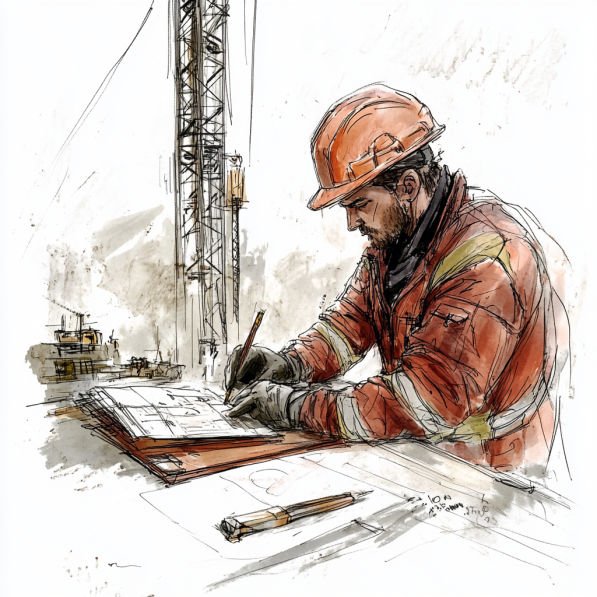The Density of Fluids and Its Impact on Pressure in Incompressible Fluids
Introduction
The density of a fluid plays a crucial role in determining the pressure exerted at a given depth within the fluid. Fluid density is a measure of how much mass is contained in a specific volume. In the context of diving or well operations, understanding fluid density helps to explain the variation in hydrostatic pressure with depth. This paper discusses how the density of fluids influences the pressure experienced at various depths, how it relates to the physical properties of the liquid, and how to calculate it.

Hydrostatic Pressure and Fluid Density
Hydrostatic pressure is the pressure exerted by a fluid at equilibrium due to the force of gravity. It increases with depth and is directly related to the density of the fluid. The formula for hydrostatic pressure in API units is given by:
Hydrostatic Pressure (psi) = Mud Density (ppg) x 0.052 x TVD (ft) or
Hydrostatic Pressure (psi) = Pressure Gradient (psi/ft) x Depth (feet)
For example, a diver at a depth of 10 feet in seawater with a pressure gradient of .455 psi/ft will experience a hydrostatic pressure of approximately 4.45 psi (.455 psi/ft x 10ft) in addition to the atmospheric pressure. In a freshwater lake at the same depth, the diver will only experience 4.33 psi (.433 psi/ft x 10ft). This difference in pressure arises because seawater is denser than freshwater and therefore has a higher pressure gradient. It is the increased salinity of the seawater that makes it heavier, resulting in a higher density and, consequently, a greater hydrostatic pressure.
As the diver descends to 100 feet, the difference in pressure becomes more pronounced. In the ocean, the diver will experience 44.5 psi (.433 psi/ft x 100ft) of hydrostatic pressure, while in the lake, the pressure will be 43.3 psi (.433 psi/ft x 100ft). The added pressure is due to the relationship between the fluid’s density or gradient and depth. The greater the fluid density, the greater the pressure at any given depth.
Impact of Depth and Fluid Density
The pressure experienced by an object in a fluid increases with depth. However, this increase is not solely dependent on the depth itself but also on the density of the fluid. In a nearly incompressible fluid such as water, the pressure at any given depth is directly proportional to both the density of the fluid and the depth at which the pressure is measured. This is why seawater, being denser than freshwater, exerts a greater hydrostatic pressure at the same depth.
Fluid Pressure in Containers
Fluid pressure is independent of the shape or volume of the container holding the liquid. For example, if you submerge a pressure sensor at a certain depth in a fluid, the pressure it measures will be the same, regardless of the container’s shape or size. The pressure at that point is determined by the depth of the fluid and its density, not by the volume of fluid or the shape of the container.
Direction of Fluid Pressure
In a fluid, pressure is exerted equally in all directions. This means that in a wellbore, the hydrostatic pressure will act not only downward but also sideways and even upwards, against the surrounding formation. This upwards pressure is what contributes to the buoyancy forces experienced by submerged objects. For example, a drill string submerged in drilling mud will appear to weigh less than in air due to the buoyant force exerted by the mud. This effect is known as buoyancy.
Measured Depth vs. True Vertical Depth
In well operations, depth can be described in two ways: measured depth (MD) and true vertical depth (TVD).
- Measured Depth (MD) is the total
 length of the wellbore as measured along the path of the well, typically from the rig floor or kelly bushing to the bottom of the well. It is the sum of all the measurements of the drill pipe joints added together as the well is drilled.
length of the wellbore as measured along the path of the well, typically from the rig floor or kelly bushing to the bottom of the well. It is the sum of all the measurements of the drill pipe joints added together as the well is drilled. - True Vertical Depth (TVD) refers to the vertical distance from a specific reference point (such as the rig floor or kelly bushing) directly down to the bottom of the well. It represents the actual depth of the well in a vertical direction.
Both MD and TVD are important in wellbore design, but for fluid pressure calculations, TVD is always used to determine the hydrostatic pressure.
Conclusion
The density of a fluid has a direct impact on the hydrostatic pressure at a given depth. In denser fluids, such as seawater compared to freshwater, the pressure at the same depth will be greater due to the increased mass per unit volume. Additionally, the depth of the fluid and the shape of the container do not affect the pressure directly; pressure is instead determined by the fluid’s density and the TVD of the point of interest. Understanding these principles is critical in various applications, such as diving, subsea BOP stacks, formation pressures, fluid dynamics, and well control operations, where pressure management is essential for safety and efficiency.
For more information on Hydrostatic Pressure and other Well Control subjects, read my Well Control Manual at: Well Control Manual
